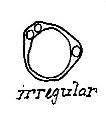Square worm holes are not as mysterious or controversial as you may think. Few researchers still cling to the outdated hypotheses of
post-holing or
by-passing, since accumulating observational evidence has demonstrated the likelihood of
piloting theory. This summary should help the reader understand the reasons behind the historical misconceptions surrounding square worm holes.
HISTORY
Square-dwelling worms (a misnomer coined by early 20th C. popularizers of natural history) have been sought for their novelty and rarity for over eight decades with the goal of reproducing this phenomenon in the laboratory. Square (and other geometrically shaped) holes are traditionally difficult to find in the field and, when exiting specimens are collected and identified, they tend to be (while all vermiform) a variety of known species, none of which have been observed to "square" their bodies. Studies, therefore, have been exercises in conjecture and therefore remain unpublished in peer-reviewed journals.
.JPG) |
| Fig 1. |
As early as the 1920s, Square-dwelling worms were described in exaggerated terms, as in this example from S. Neimeyer's
Collection of Earthly Oddities (Fig. 1). Amateur naturalists flocked to find and domesticate these creatures that could apparently build their own lean-tos
(a long-debunked folk tale now demoted to the rank of back-laboratory trivia). Thirty years later, the cause was taken up by Dr. R. Moon as an enthusiastic graduate student, looking to make his name by moving cryptozoological history into the realm of observable science. His early field notes (Fig. 2) renewed interest among the scientific community despite his drawings' exaggerated geometricity.
 |
| Fig 3. |
Upon circulation of these notes at various conferences, the holes were quickly explained, sight unseen, by several researchers with competing theories.
Post-holing was immediately the most popular explanation, relying on the presence of rasping mouthparts in each of the worm species collected from the holes. This theory postulated that the worms scraped out (Fig. 3)one corner at a time in search of decaying plant matter as a defensive adaptation (reduced exposure to predators).
 |
| Fig 4. |
Another theory that did not catch on immediately was called
By-passing, which introduced hitherto unobserved nematodes into the mix. This explanation involved a stationary worm in a cylindrical passageway, bypassed repeatedly and on different sides by nematodes taking advantage of an easier path to the surface (Fig. 4).
 |
| Fig 5. |
By-passing was largely ignored until Dr. Moon circulated more accurate drawings (Fig. 5)
depicting inconsistent hole perimeters, and the retired Neimeyer himself proposed a mechanism for nematodes to assist in hole shaping via by-passing (Fig. 6). This theory shared the spotlight with post-holing until Moon pointed out the absence of nematodes exiting the hole whenever a stationary worm was observed (though nematodes are frequently found
entering a square hole).
Nor have any worms been observed rasping away corners with their mouthparts. Good science tells us the proposed mechanism can only be validated by field observations, none of which were available to support either theory.
HOW DO WE EXPLAIN IT?
The prevailing theory today explains both the hole shapes observed, as well as the long-noted re-entry of nematodes into the empty holes. The theory ties in interestingly with my own research into nematode piloting, with the exception that the livery animal is a worm. This explanation posits that the nematodes are only using worms for a one-way ride to the surface, having no efficient way to travel through packed soil. Depending on the alignment of nematodes (Fig. 7.),
 |
| Fig 7. |
the hole shape will vary. The presence of pilot nematodes on stationary worms would not be observed because they remain fixed to the side of the worm below the surface, not attempting to by-pass it. It is impossible to predict where a piloted worm is going to emerge and, therefore, unlikely to observe piloting in action.
What can be observed, however, is the return trip, widely captured by those patient enough to wait by their find. In a photo by graduate student Patti Michaels, a nematode is seen entering a "square" hole (Fig. 8).
 |
| Fig 8. |
Michaels has captured innumerable photo sequences and videos of nematodes sometimes piling into the holes from which they emerged (the trip down is much easier than the trip up!). A typical sequence is shown below (Fig. 9-11).
Clearly there is more work to be done in explaining the presence of square worm holes, but it must be acknowledged that the scientific community has adapted admirably to new observations, however sparse and inconclusive they may be. Additional research on piloting with other livery species will be made available soon, and may shed some additional light on this perplexing phenomenon.
If you have additional research or questions about square worm holes, send an email to
TheMermithidTruth@gmail.com. Please do not send support for
post-holing or
by-passing theory.
.JPG)












I have been collecting holes for a hobby and I have never seen a square worm hole before. I bet that they are very rare. I will trade you a rare Australian fence post hole or and even more hard to find ancient fossilized hole that is more that 4 billion years old. Let me know if you want to trade and I will send either one of them Fed Ex as soon as possible.
ReplyDelete